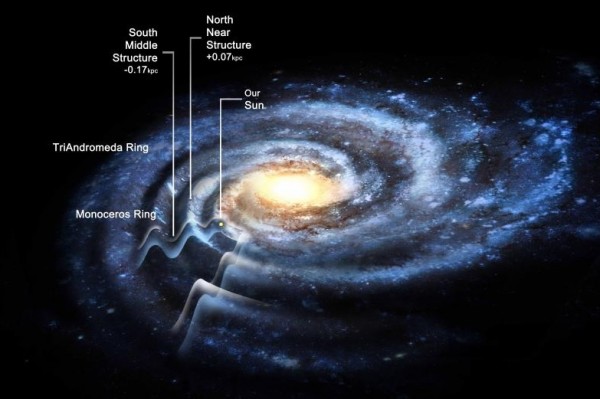The Milky Way is 50% Larger than First Thought
| Ana Verayo | | Mar 12, 2015 07:17 AM EDT |
(Photo : Rensselaer RPI News) A "rippled" Milky Way may be 50 percent larger than previously estimated
The Milky Way is apparently 50 percent larger than what astronomers previously thought and a new study reveals its galactic disk possesses several concentric ripples stretching outward.
This new research was conducted by an international team led by Heidi Jo Newberg from the Rensselaer Polytechnic Institute after restudying astronomical data from the Sloan Digital Sky Survey. This data obtained from 2002 revealed the presence of a bulging ring of stars beyond the plane of the Milky Way.
Like Us on Facebook
The new findings show these features are already identified as rings and part of the galactic disk that extends from the width of the Milky Way some 100,000 light years to 150,000 across deep space, says Yan Xu from the National Astronomical Observatories of China and formerly from Rensselaer Polytechnic Institute, the lead author of the paper.
Newberg already established the existence of the Milky Way's "Monoceros Ring," which can be described as an over-density of stars from the outer edges of the galaxy that bulges from its galactic plane.
She also observed some evidence of another over density of stars located between the Monoceros Ring and our Sun. With new data available from the Sloan Digital Sky Survey, researchers are now hoping to decipher this cosmic phenomenon.
During their investigation, researchers discovered four anomalies. One lies in the northern galactic plane at two kilo parsecs from the sun; another south of the plane at four to six kilo parsecs; a third one to the north of the plane at eight to 10 kilo parsecs and the last one lies to the south at 12 to 16 kilo parsecs from the sun.
The Monoceros Ring is associated with the third ripple. Researchers discovered these oscillations appear to be parallel with the locations of the Milky Way's spiral arms.
These new findings also support new research about how galaxies orbiting the Milky Way like dwarf galaxies can contain dark matter and produce a similar rippling effect. These ripples could also be the effect of the presence of the elusive dark matter that is known to make-up most of the mass in the expanding universe.
This study was published in the Astrophysical Journal.
TagsMilky Way Galaxy is 50% Larger Than First Thought, milky way galaxy, milky way ripples 50 percent bigger larger, sloan digital sky survey
©2015 Chinatopix All rights reserved. Do not reproduce without permission
EDITOR'S PICKS
-

Did the Trump administration just announce plans for a trade war with ‘hostile’ China and Russia?
-

US Senate passes Taiwan travel bill slammed by China
-

As Yan Sihong’s family grieves, here are other Chinese students who went missing abroad. Some have never been found
-

Beijing blasts Western critics who ‘smear China’ with the term sharp power
-

China Envoy Seeks to Defuse Tensions With U.S. as a Trade War Brews
-

Singapore's Deputy PM Provides Bitcoin Vote of Confidence Amid China's Blanket Bans
-

China warns investors over risks in overseas virtual currency trading
-

Chinese government most trustworthy: survey
-

Kashima Antlers On Course For Back-To-Back Titles
MOST POPULAR
LATEST NEWS
Zhou Yongkang: China's Former Security Chief Sentenced to Life in Prison

China's former Chief of the Ministry of Public Security, Zhou Yongkang, has been given a life sentence after he was found guilty of abusing his office, bribery and deliberately ... Full Article
TRENDING STORY

China Pork Prices Expected to Stabilize As The Supplies Recover

Elephone P9000 Smartphone is now on Sale on Amazon India

There's a Big Chance Cliffhangers Won't Still Be Resolved When Grey's Anatomy Season 13 Returns

Supreme Court Ruled on Samsung vs Apple Dispute for Patent Infringement

Microsoft Surface Pro 5 Rumors and Release Date: What is the Latest?










